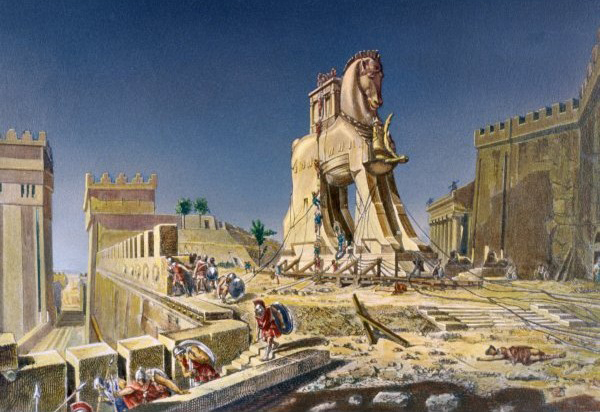


The site of the city of Troy is rich in history. Dating back thousands of years, and well known for the famous Trojan War, it was built and rebuilt many times as a result of it being destroyed. The original city of Troy dated back to 3000 B.C and until relatively recently it was believed to have been nothing more than a tale and not an actual city. The tale of the Trojan War was an epic story of a battle that was waged against the city of Troy, it is believed to be one of the most important events in Greek Mythology.
A German entrepreneur named Heinrich Schliemann believed the story of Troy was more than just a tale and in 1870 begun researching and attempted to validate the original tale of Troy told by Homer. Heinrich joined English Archaeologist Frank Calvert in digging the site; Calvert had purchased land in the area and had been digging 2 years prior to Heinrich’s arrival. In 1873 Heinrich successfully uncovered the city in Turkey, which still remains today as one of the worlds most famous archaeological discoveries.
When excavations begun in 1870, Heinrich commenced digging illegally, without a permit from the Turkish government. During this period many levels of the city were discovered which showed that the city had been rebuilt multiple times. This unpermitted digging lasted a year until Heinrich was forced to gain the permission to excavate.
The intricate process of digging continued in 1871 but involved destroying many of the newer recreations of the city in the process of digging down to the first version of the city of Troy. What Heinrich believed to be the oldest city, discovered the furthest down was believed to be the city of Troy from Homer’s tale. Along with the discovery of this city, many ancient ornaments and artefacts were uncovered. The included shields, helmets, cauldrons, vases, spearheads earrings, and approximately 9000 small ornaments. Upon discovering these artefacts, Heinrich attempted to smuggle them from the country but was discovered by the Turkish government, who then demanded compensation for the findings. The compensation to the Turkish government was under 20% of the actual value of these items. The items were bought and displayed by a museum in Berlin.
Excavations continued to see what else could be uncovered. Through further diggings, researchers realised that what they previously believed to be the oldest settlement of troy was actually the second oldest (Troy II). Ancient Greek historians place the Trojan War in either the 12th, 13th or 14th century, which meant that the city from 3000 B.C that Heinrich had discovered was not the one from the famous tale. Along with these findings, researchers uncovered that the majority of the initial treasure uncovered site came from outside the city walls. Controversy surrounded Heinrich’s initial findings and the authenticity of the artefacts was questioned further when it was realised that he’d stolen them.
In 1993 archaeologists from around the world examined the artefacts and they were authenticated as being from the Bronze Age, which meant that they were not fakes.
Even though the site was found over a hundred years ago, excavations continue at the site of Troy today, in an attempt to gain a better understanding of the history. So far it is understood that a minimum of nine cities were built upon the same site. Details on these nine cities and when they existed are as follows:
– Troy I (3000–2600 B.C)
– Troy II (2600-2250 B.C)
– Troy III (2250-2100 B.C)
– Troy IV (2100-1950 B.C)
– Troy V (20-18th Centuries B.C)
– Troy VI (17-15th Centuries B.C)
– Troy VII (1300-950 B.C) The most likely setting for Homer’s tale.
– Troy VIII (700-85 B.C)
– Troy IX (85 B.C – 500 A.D)
The original excavations of Heinrich had damaged many of the newer versions, researchers believe the seventh reconstruction of Troy is most likely to be the city from the tale by Homer, dated somewhere around 1250 B.C. The site of these diggings was added to the UNESCO World Heritage list in 1998. Schliemann eventually conceded that the city he had found was not the one from the tale but never made a publishing admitting so.